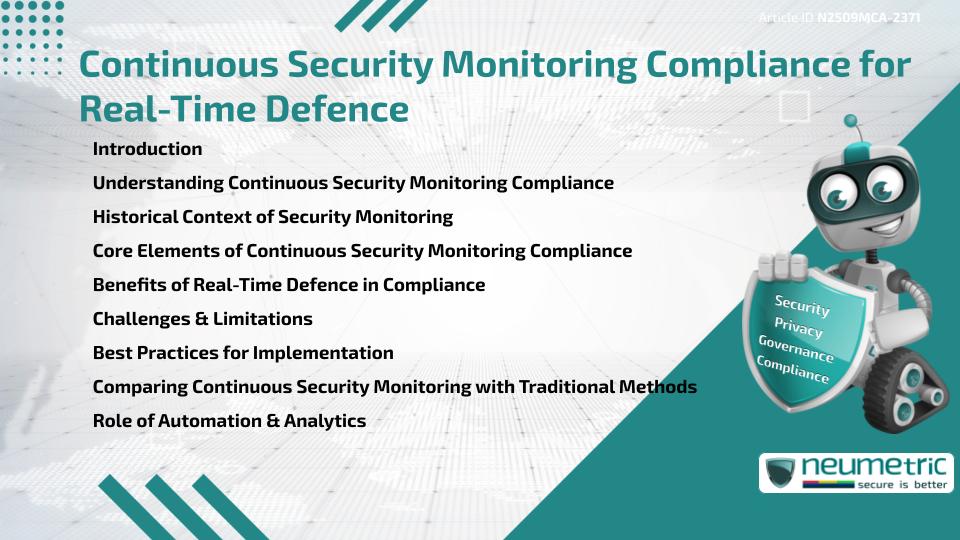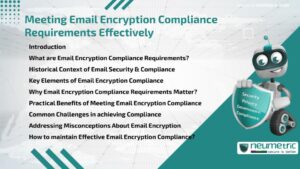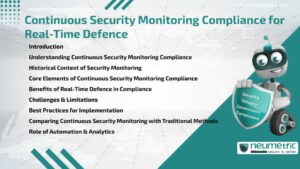Table of Contents
ToggleIntroduction
Continuous Security Monitoring Compliance is a process that ensures Organisations maintain security standards while defending against real-time Threats. It integrates Compliance Frameworks with automated Monitoring Tools to provide constant oversight of information systems. This approach allows Organisations to detect Vulnerabilities quickly, prevent breaches & stay aligned with regulatory requirements. Continuous Security Monitoring Compliance is crucial in industries such as Finance, Healthcare & Government, where Sensitive Data is at stake. The method balances security enforcement with Compliance obligations, making it a cornerstone of modern Cybersecurity Strategies.
Understanding Continuous Security Monitoring Compliance
At its core, Continuous Security Monitoring Compliance involves using automated tools to monitor systems against both internal Policies & external regulations. Unlike periodic audits, which occur only at fixed intervals, Continuous Monitoring provides ongoing visibility into the security posture. For example, a Healthcare provider subject to HIPAA regulations can use this approach to detect unauthorized access attempts as they happen, rather than waiting for a scheduled Audit.
Historical Context of Security Monitoring
Security Monitoring has evolved significantly over time. In the past, Compliance was measured primarily through manual assessments & annual audits. These processes were slow, prone to errors & often left Organisations exposed between Audit cycles. With the rise of advanced Threats, the need for real-time defence became apparent. The shift toward Continuous Security Monitoring Compliance reflects an industry-wide recognition that traditional methods are insufficient for modern Risks.
Core Elements of Continuous Security Monitoring Compliance
The Framework typically includes:
- Automated log collection & analysis
- Real-time Intrusion Detection Systems [IDS]
- Continuous Vulnerability Assessments
- Compliance Dashboards for reporting
- Alerting mechanisms to flag anomalies
These elements work together to create a system that not only enforces Compliance but also provides actionable insights to security teams.
Benefits of Real-Time Defence in Compliance
Real-time defence through Continuous Security Monitoring Compliance offers several advantages. First, it shortens the time between detection & response, reducing the impact of potential breaches. Second, it helps Organisations demonstrate Compliance continuously rather than sporadically. Finally, it fosters trust among Stakeholders who rely on the protection of Sensitive Data. A strong Compliance strategy supported by real-time monitoring enhances both resilience & credibility.
Challenges & Limitations
Despite its benefits, Continuous Security Monitoring Compliance is not without challenges. Implementation costs can be high, particularly for small Organisations. There may also be difficulties integrating Monitoring Tools with legacy systems. Additionally, constant alerts may lead to “alert fatigue,” causing teams to overlook genuine Threats. Organisations must weigh these challenges against the critical need for security.
Best Practices for Implementation
To adopt Continuous Security Monitoring Compliance effectively, Organisations should:
- Define clear Compliance objectives aligned with Industry Regulations
- Invest in scalable automation tools
- Train staff to respond efficiently to alerts
- Establish processes for regular review & tuning of monitoring systems
- Ensure that monitoring results are tied back to Compliance reporting
Comparing Continuous Security Monitoring with Traditional Methods
Traditional Compliance methods relied heavily on checklists & point-in-time audits. Continuous Security Monitoring Compliance, by contrast, delivers constant visibility & proactive defence. It is similar to the difference between a snapshot & a live video feed. The latter provides more context, real-time updates & the ability to act before issues escalate.
Role of Automation & Analytics
Automation & analytics are the driving forces behind Continuous Security Monitoring Compliance. Automation reduces manual errors & speeds up detection, while analytics help security teams interpret large volumes of data to spot trends. Together, they enable proactive decision-making & strengthen real-time defence.
Takeaways
Continuous Security Monitoring Compliance integrates Compliance Requirements with real-time Monitoring Tools. It transforms security from a reactive to a proactive discipline, enabling Organisations to protect Sensitive Data while meeting regulatory obligations. Though it presents challenges, its benefits far outweigh limitations when implemented thoughtfully.
FAQ
What is Continuous Security Monitoring Compliance?
It is the integration of Compliance standards with real-time Monitoring Tools to ensure constant oversight of security systems & regulatory adherence.
Why is Continuous Security Monitoring Compliance important?
It ensures that Organisations remain compliant with regulations while protecting against real-time Threats that periodic audits may miss.
How does Continuous Monitoring differ from periodic audits?
Periodic audits provide snapshots of Compliance, while Continuous Monitoring offers ongoing, real-time visibility into security systems.
What industries benefit most from Continuous Security Monitoring Compliance?
Sectors such as Finance, Healthcare & Government benefit most due to the sensitive nature of the data they handle.
What are the challenges of implementing Continuous Security Monitoring Compliance?
Challenges include high implementation costs, integration with legacy systems & potential alert fatigue from constant notifications.
How does automation support Continuous Security Monitoring Compliance?
Automation accelerates detection, reduces human error & ensures that Compliance tasks are carried out consistently.
Can small Organisations adopt Continuous Security Monitoring Compliance?
Yes, but they may need to adopt scalable solutions & prioritise the most critical Compliance & monitoring objectives.
References
Need help for Security, Privacy, Governance & VAPT?
Neumetric provides organisations the necessary help to achieve their Cybersecurity, Compliance, Governance, Privacy, Certifications & Pentesting needs.
Organisations & Businesses, specifically those which provide SaaS & AI Solutions in the Fintech, BFSI & other regulated sectors, usually need a Cybersecurity Partner for meeting & maintaining the ongoing Security & Privacy needs & requirements of their Enterprise Clients & Privacy conscious Customers.
SOC 2, ISO 27001, ISO 42001, NIST, HIPAA, HECVAT, EU GDPR are some of the Frameworks that are served by Fusion – a SaaS, multimodular, multitenant, centralised, automated, Cybersecurity & Compliance Management system.
Neumetric also provides Expert Services for technical security which covers VAPT for Web Applications, APIs, iOS & Android Mobile Apps, Security Testing for AWS & other Cloud Environments & Cloud Infrastructure & other similar scopes.
Reach out to us by Email or filling out the Contact Form…





